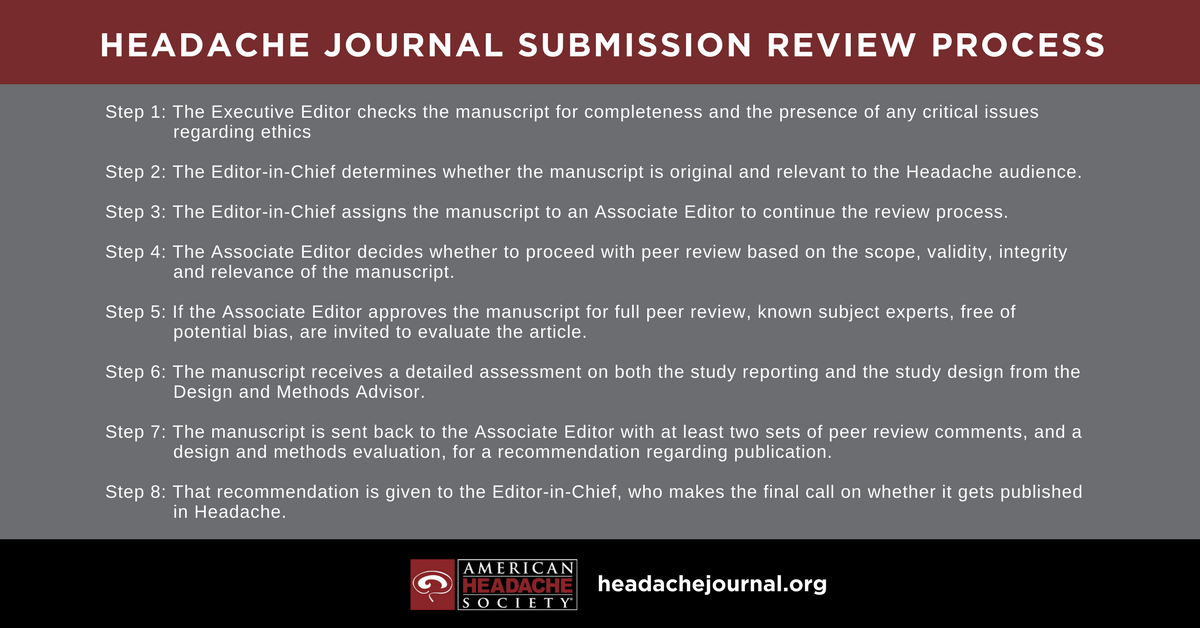
How Headache Evaluates Manuscript Submissions
Interested in submitting a manuscript to Headache? Find out exactly what the editors are looking for here.
Headache: The Journal of Head and Face Pain applies a rigorous review process to evaluate which manuscripts will be featured in the publication. To outline the requirements of the Editorial Board, Jason Roberts, PhD, explains Headache’s manuscript evaluation process and offers key insights to draft a winning submission for publication.
Key Criteria for Selection
Any article accepted in Headache must satisfy the following criteria:
- The article presents original material that in some capacity advances understanding
- The results are built upon sound methodology and, if appropriate, statistical analyses
- The conclusions are appropriate for the information presented
- The content is of interest to the readership of Headache
- The manuscript is within the top half of articles published in the field
According to Roberts, aside from this mandatory criteria, there is no firm standard for what makes an exemplary manuscript; however, there are a some components editors and reviewers look for when deciding whether or not a study or article should be approved for publication.
The “So What?” Factor
“So what?” is the number one question authors must ask themselves before submitting their work. If that question isn’t answered in a clear and compelling way, the manuscript will likely be rejected. View the “so what” factor as the reason why people will want to read this information.
Other questions submissions should answer are less subjective. Examples provided include: “Are the claims appropriately discussed in the context of extant literature?” and “Is the sample selection and size appropriate?” These guidelines can serve as a useful checklist when self-evaluating a potential submission. To fully vet your manuscript before submitting, read through the 22 questions reviewers and editors ask of each manuscript they consider for publication.
The Peer Review Process
Headache operates a double-blind peer review process. This means reviewers are blinded to the authors and authors are blinded to the reviewers. Headache has a particularly rigorous approach to peer review in order to maintain the standard of the publication. The process is broken down into eight key steps, which are detailed in the original publication “How Manuscripts are Evaluated at Headache: The Journal of Head and Face Pain1,” available on the Headache journal website.
Over the years, Headache editors have built a robust mechanism for peer review management, with several checks and balances. Compared with other mid-sized journals, Headache has a particularly rigorous approach to peer review, resulting in sufficiently validated, well-written reports of some of the most recent on going research in Headache Medicine. In fact, ensuring authors receive a high quality peer review experience is their daily mantra.

The American Headache Society is committed to keeping its members up to date on the most innovative and meaningful advancements in the realm of headache medicine. One of many initiatives to support that mission is our publication of Headache: The Journal of Head and Face Pain, published ten times per year, which highlights the latest findings in the realm of headache medicine research. Our “From the Journal” series offers a preview of some of the groundbreaking work detailed in Headache. Enjoy access to the full catalogue of content plus a print subscription included with an American Headache Society Membership. Click here to become a member today.


